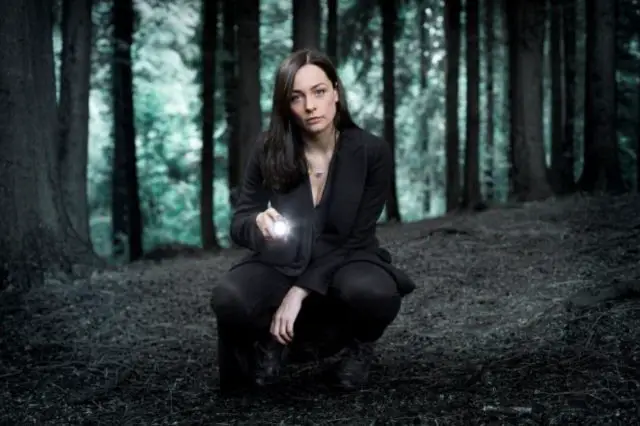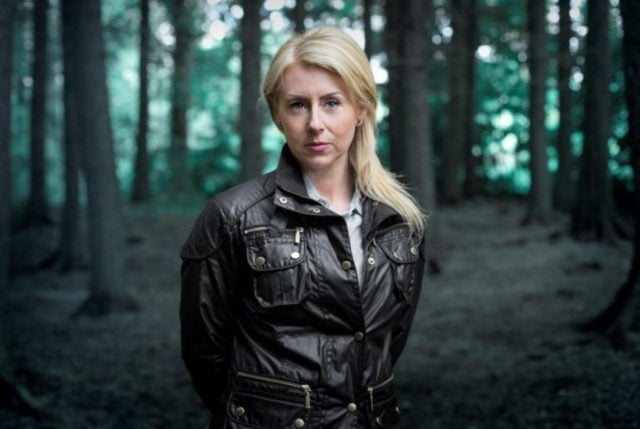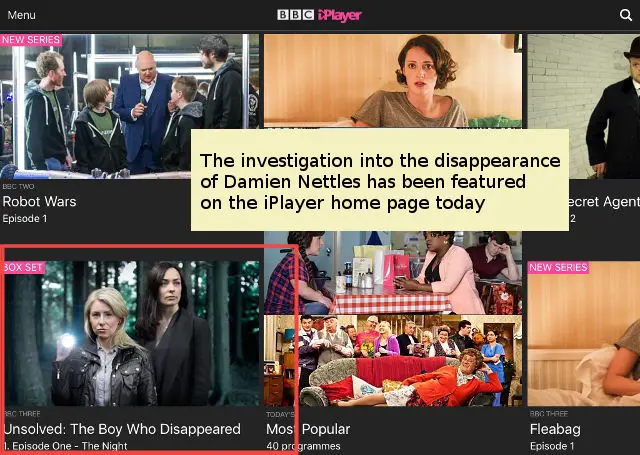Earlier today, BBC Three launched, Unsolved: The Boy Who Disappeared, a serialised real life crime investigation.
The interviews below with the reporters who worked on the series give a great insight as to why they became involved, what challenges they met and what their hopes for the case are following the investigation.
Meet the reporters: Alys Harte

What made you want to investigate Damien’s case?
When we came to this story, over a thousand people had already been involved in the police investigation; they had taken hundreds of witness statements, reviewed thousands of documents.
Yet the case remained unsolved. That’s extraordinary. But this story is about more than a missing boy. It was about the ripple effect that occurs after an event like this – and a family and a community coming to terms with this kind of grief – it’s called “ambiguous loss”.
Because no one actually knows what happened to Damien, his family have been left with a very complicated grief – there is no body, no grave, and no closure. That’s a very hard thing to get your head around. This series is as much about the complexities of a family trying to deal with that, as it is about what happened that night, failures in the early police investigation, and the rumour mill on the island.
Where do you start investigating a disappearance from nearly twenty years ago?
You start at the beginning and work back. For us, it was the night Damien went missing. Nailing down a timeline was crucial. After that, we had to get to know Damien; his habits, his friends, what he did in his spare time.
There’s no such thing as too much information. In this case, nothing was straightforward, so it was important to speak to as many people as possible – and to keep an open mind. Talking to witnesses years later – in this case almost twenty years later – can yield surprising results. You never know where they might lead you.
What are the main challenges?
Taking on a story like this is a huge responsibility. You’re constantly mindful of the existence of a grieving family desperate for answers. But then there was the test of wading through almost twenty years of rumour, speculation and lies.
Some stories have been retold so many times that they have become part of the mythology of the Isle of Wight. At times, it was difficult to decipher fact from fiction.
How important was it to work closely with Damien’s family and friends?
We couldn’t have made this series without Valerie, James and the rest of the Nettles family. They gave us so much of their time and energy, never tiring of answering questions or running over old ground.
Their contribution to the films was invaluable, not only to helping us get to know Damien, but also assisting with the investigation itself.
What was the most satisfying or surprising part of the investigation?
For me, it was sitting down in front of some of the key players. Although the Nettles family had never met any of these people, they had become a constant presence in their lives, looming like a kind of spectre in the family story.
They knew their names and for almost two decades, the family strongly believed these people were involved in Damien’s disappearance. So even for us, the moment when we finally sat down in front of them was significant.
What is it about these types of cases and programmes (MAM, Serial) that is so interesting
for audiences?
Truman Capote’s “In Cold Blood” is one of my favourite books of all time – a gripping true crime story, well told, with complex characters and real jeopardy. That’s what makes this genre so popular – they are real stories, with real people and real consequences. The jeopardy is genuine. That’s the thing about real life – you don’t know what’s going to happen next.
When I watched the last episode of “The Jinx”, the first thing I did was lock my front door. Even though I was thousands of miles away from this man, he was real and I had witnessed an extraordinary confessional moment unfold in front of me. It wasn’t the work of script writers. It was real. Look at the latest development in Adnan Syed’s case – it’s impossible to know if that would have happened without the popularity of Serial, but it seems unlikely.
Why would you recommend people watch Unsolved?
It’s a completely new format for BBC Three; serious forensic journalism but filmed like a flyon-the- wall documentary. The entire project was an experiment. That’s really exciting.
Plus, it provides a great insight into investigative journalism.
Meet the reporters: Bronagh Munro

What made you want to investigate Damien’s case?
When I was looking at the many unsolved cases in the UK, Damien’s story really drew me in. I just didn’t believe a 16-year-old boy could simply vanish into thin air, and definitely not from the main street in small town like Cowes, without someone knowing something.
I’m from a small island, with a strong sense of community and I know that a young boy disappearing is a life shattering event not just for the family but it also has a deep impact on local people. No one can just disappear without leaving a trace, but it appeared, that this is exactly what Damien did.
Rumours abounded that he had simply fallen into the sea. I trawled the news reports, his family refused to accept this theory. I repeatedly read that Damien was a happy, content boy who loved life. He appeared to have no reason to run away. Something just didn’t fit.
When I first called Valerie Nettles, Damien’s mother, her sadness and frustration made a big impact on me. Yet behind the intangible grief, there was a determination and resilience that I immediately admired and responded to. She was a fighter and I understood that she could not move on with her own life until she found the answers to what had happened to her son. She was caught in limbo.
Today, historical cases as they are known, struggle to capture the interest of people who everyday face media reports of new atrocities.
I knew Valerie faced an uphill battle; Damien’s case was almost 20 years old, she was frustrated with the police, the loss of vital evidence and the failure to retain records had hampered the case, she was exhausted, and all the resources she had to hand to find her son had been used.
From what she told me, I wanted to help her, I felt we could.
Where do you start investigating a disappearance from nearly twenty years ago?
I was under no illusion of the task ahead, the police with all their resources had been working on this case for 20 years. Other journalists and private detectives had been involved with no success.
You have to keep an open mind, explore all the avenues in front of you and look for as much hard evidence as you can to prove or disprove a theory. And in Damien’s case there was nearly as many theories as the number of years he had been missing.
Every investigation is different, but fundamentally there are similarities. In my head I place the person in the centre of the investigation and then I begin to make contact with anyone and everyone who might have known him. Those closest to person are always the first port of call.
They provide invaluable information that that would give us an insight into who Damien was and what was happening in his life was like back then. It’s always step by step, bit by bit. You are building a jigsaw.
I had to look at the obvious answers first; Damien really could have just run away or fallen in the sea. But very quickly I found myself looking past these theories and past the people who wanted to believe this. The oral evidence I was discovering didn’t lend itself to that. You look at and conduct the investigation like a criminal case if you believe there was wrongdoing.
It is important to get as much written evidence relating to the case as possible, often with fresh eyes and a different perspective there is significant information that could have been overlooked previously.
There was little of that in this case. I began to look for where there was opportunity for something to have happened to Damien. The social circles he was in, his jobs, his friends. I wanted to understand what possible motive anyone could have had for harming Damien and that led me to those who were rumoured to be involved.
Historical cases are notoriously difficult. This one proved to be no different.
What are the main challenges?
We are filmmakers, but I am investigative journalist at heart, so balancing the need to get answers for the family equally, with producing something that is engaging and appealing to an audience is tough.
The case was twenty years old, vital evidence and records had been lost, memories had faded, people had moved on.
There was no crime scene, no body, and only circumstantial evidence to follow. I couldn’t have picked a tougher case if I had tried. Tracking down witnesses and contributors and getting them to talk was the easy part, untangling and proving their stories were a different matter.
Rumour and speculation were rife surrounding Damien’s disappearance and his story had been told time and time again; it was part of island mythology. The family had very little if any documentation in relation to the case, so had to rely on oral evidence.
I could never be sure if what people told us was actually their own true recollection of the facts or if there memories were tinged by what other people had said. Every detail had to be tested and checked before we could rely on it.
Do I feel that there was a wall of silence at times, yes.
Do I believe people deliberately misled us, yes.
The tougher it got, the more determined I became that there was information out there; people did know what happened to Damien. It was not just a missing person’s case. Quite apart from that – moving to the island for nearly four months was tough. Setting up without all the usual resources was a culture shock.
The case became all consuming. I felt I lived and breathed it 24hrs a day.
How important was it to work closely with Damien’s family and friends?
I feel it is a privilege when families share their stories with us and give us permission to work on their cases. We are never approaching them for good news, often they are sharing the most painful and intimate details. It is huge responsibility to set yourself up as someone who could help them.
From the beginning I needed Valerie to understand that we might never give her any more answers than she had already, but we would certainly try. I don’t believe any investigation can be successful without the ‘buy in’ and commitment from the family and their friends.
I know the family often hold vital evidence unbeknown to themselves. From the outset I always make them aware that I will talk to them and ask them more questions than they have ever been asked in their life. I will spend hours going through their memories, the history of the case, and any documents I can get my hands on.
Written documents are gold dust in an investigation like this. Memories fade and history can become distorted but the written word doesn’t change. Often the intensity of our work is difficult for the families, it bring up painful memories and makes them question what they previously believed.
What was the most satisfying or surprising part of the investigation?
On a personal level the investigation becomes all-consuming, I know if I get results I could help the Nettles family, and that is rewarding.
Results aside, knowing that we have provided a platform for Valerie and the Nettles family to tell their story is satisfying. Knowing how difficult it has been for them, it is good to be able to provide them with an opportunity to reach a wider audience and perhaps this may help them get closer to finding Damien.
In terms of surprises though, there were many and not all of them good.
The most significant one for me was discovering how careless people were with the truth. We discovered that the Nettles family had been approached many times over the last twenty years by people only seeking to further their own interests at the expense of the Nettles family. These people provided information that not only did not help the police find Damien, but actively wasted police time and diverted resources in investigating lines of enquiry that went nowhere.
I was shocked and disappointed to learn people had approached Valerie in person and recounted tales of what happened to Damien with absolutely no basis in truth or facts.
What is it about these types of cases and programmes (MAM, Serial) that is so interesting for audiences?
To work on an investigation like this is truly gripping for those involved. The stakes are higher, you are dealing with real families and often the most serious of crimes. There is real jeopardy and complex characters that isn’t the work of script writers. I feel the audience enjoys the integrity of the story being told as it really happened.
Making a Murderer is a great example of this. I feel that audiences respond to this, because the stories are real and the contributors compelling.
There is a real rise in the popularity of this genre, with some truly great cases being covered. The Jinx was an utterly fascinating watch, because of their main character, and the additional online content allowed audiences to delve deeper in to his case.
It allows the audience to become arm chair detectives and get stuck into the investigation themselves. Hopefully the audience will respond in a similar way to the online content that will be released in tandem with our films. The films are short so it’s been great to be able to give certain characters space to develop.
For me the greatest aspect about this type of programme is that they can have real impact and affect peoples’ real lives. Serial, the American radio Podcast, has done just that – the latest development in the Syed case. You are left in doubt as to whether this could have happened so quickly if at all, if not for the popularity and work by the journalists involved.
Another great example of the effect these investigations can have is the fifty year old Elise Frost murder. Where a BBC Radio Four investigation allegedly prompted the re-opening of the case.
Why would you recommend people watch Unsolved?
It’s a different style of film making for current affairs, the cameras rolled from day one, there was no research period. The audience gets to follow us (the reporters) through all the highs and lows of trying to investigate Damien’s case. They see our success and failures, and the everyday life of investigative reporters, warts and all.
The true story of the heartache, bravery and frustration of the Nettles family will not be lost on the audience, as they follow the family in their search for the truth.
The characters we meet are real and compelling and you cannot predict what they are going to say or do. Often we found ourselves talking to people who we never thought for a second would open the door to us and the audience gets to see this first hand as it happens.
As the story unfolds the audience will get to hear real testimony from characters as we hear it, and they will have to make up their own minds as to who is telling the truth and who is not. Apart from that, you get the bonus of being able to ‘binge’ watch of all the episodes, as all eight of them are going up together. Or, because each of the episodes are only approximately 15 minutes long, they are accessible and easily watched on any device, even on your tea break.





